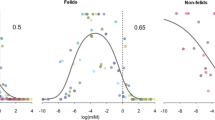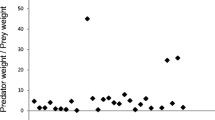Summary
Variation in body size (weight) is examined across the order Carnivora in relation to taxonomy (phylogeny), latitude, habitat, zonation, activity cycle, diet, prey size, and prey diversity. Significant differences in body weight are observed with respect to family membership. Some of these differences may be explained by phylogenetic history and/or dietary effects. Body weight is not correlated with habitat, zonation, activity cycle or latitudinal gradients. Significant differences in body weight are found among insectivorous, herbivorous and carnivorous species, and some of these differences may relate to energetic constraints. Among predatory carnivores, prey size and diversity increases with body weight. The adaptive significance, both intra- and inter-specifically, of prey characteristics (size, availability, diversity) and carnivore body weight qualities (strength, endurance, hunting technique) is discussed.
Similar content being viewed by others
References
Barnett RJ (1977) Bergmann's rule and variation in structures related to feeding in the gray squirrel. Evolution 31:538–545
Bekoff M (ed) (1978) Coyotes: their biology, behavior and management. New York, Academic Press
Bekoff M (1982); Coyote. In: J chapman, G Feldhamer (eds). Wild Mammals of North America. Baltimore, Johns Hopkins, pp 447–459
Bekoff M, Daniels TJ, Gittleman JL (1984) Life history patterns and the comparative social ecology of carnivores. Ann Rev Ecol Syst 15:191–232
Bergmann C (1847) Über die Verhältnisse der Wärmeökonomie der Thiere zu ihrer Größe. Göttinger Studien 3:595–708
Bertram BCR (1978) Living in groups: predators and prey. In: JR Krebs, NB Davies (eds). Behavioural ecology. Blackwell, Oxford, pp 64–96
Bertram BCR (1979) Serengeti predators and their social systems. In: ARE Sinclair, M Norton-Griffiths (eds). Serengeti: dynamics of an ecosystem. Univ Chicago Press, Chicago, pp 159–179
Bourlière F (1975) Mammals small and large: the ecological implications of size. In: F Golley, K Petrusewicz, L Ryszokowski (eds). Small Mammals: their productivity and population dynamics. Cambridge Univ Press, Cambridge, pp 1–8
Boyce MS (1979) Seasonality and patterns of natural selection for life histories. Am Nat 114:569–583
Brown JH (1975) Geographical ecology of desert rodents. In: M Cody, J Diamond (eds). Ecology and evolution of communities. Harvard Univ Press, Cambridge, pp 315–341
Brown JH, Lee AK (1969) Bergmann's rule and climatic adaptation in woodrats (Neotoma). Evolution 23:329–338
Calder WA III (1984) Size, function, and life history. Harvard Univ Press, Cambridge
Caraco T, Wolf LL (1975) Ecological determinants of group sizes of foraging lions. Am Nat 109:343–352
Charles-Dominique P (1975) Nocturnality and diurnality, an ecological interpretation of these two modes of life by an analysis of higher vertebrate fauna in tropical forest ecosystems. In: WP Luckett, F Szalay (eds). Phylogeny of primates. Plenum, New York, pp 477–529
Cherry LM, Case CM, Kunkel JG, Wyles JS, Wilson AC (1982) Body shape metrics and organismal evolution. Evolution 36:914–933
Clutton-Brock TH, Harvey PH (1977) Primate ecology and social organisation. J Zool 183:1–39
Clutton-Brock TH, Harvey PH (1979) Comparison and adaptation. Proc Roy Soc Lond 205:547–565
Clutton-Brock TH, Harvey PH (1983) The functional significance of variation in body size among mammals. In: JF Eisenberg, DG Kleiman (eds). Advances in the study of mammalian behavior. Spec Publ Am Soc Mamm, Lawrence, Kansas, pp 532–563
Clutton-Brock TH, Harvey PH (1984) Comparative approaches to investigating adaptation. In: JR Krebs, NB Davies (eds). Behavioural ecology, 2nd ed Blackwell, Oxford, pp 7–29
Davis S (1977) Variation of the fox,Vulpes vulpes, in the palearctic region today, and in Israel during the late quarternary. J Zool 155:485–497
Dorst J, Dandelot P (1969) A field guide to the larger mammals of Africa. Houghton Mifflin, Boston, MA
Eisenberg JF (1981) The Mammalian Radiations. Chicago Univ Press, Chicago
Eltringham SK (1979) The ecology and conservation of large African mammals. Macmillan, London
Estes RG, Goddard J (1967) Prey selection and hunting behavior of the African wild dog. J Wild Mgt 31:52–70
Ewer RF (1973) The Carnivores. Cornell Univ Press, Ithaca
Fleagle JG (1978) Size distribution of living and fossil primate faunas. Paleobiology 4:67–76
Fuentes ER, Jacksié FM (1979) Latitudinal size variation of Chilean foxes: tests of alternative hypotheses. Ecology 60:43–47
Gambaryan PP (1974) How animals run: anatomical adaptations. Halsted Press, New York
Garland T (1983a) The relation between maximal running speed and body mass in terrestrial mammals. J Zool 199:157–170
Garland T (1983b) Scaling the ecological cost of transport to body mass in terrestrial mammals. Am Nat 121:571–587
Geist V (1974) On the relationship of social evolution and ecology in ungulates. Am Zool 14:205–220
Gittleman JL (1984) The behavioural ecology of carnivores. PhD Thesis, University of Sussex
Gittleman JL, Harvey PH (1982) Carnivore home-range size, metabolic needs and ecology. Behav Ecol Sociobiol 10:57–63
Gorman ML (1979) Dispersion and foraging of the small Indian mongoose,Herpestes auropunctatus (Carnivora: Viverridae) in the Fijian Islands. J Zool 178:237–246
Griffiths D (1980) Fotaging costs and relative prey size. Am Nat 116:743–752
Grobler JH (1981) Feeding behaviour of the caracalFelis caracal Schreber 1776 in the Mountain Zebra National Park. S Afr J Zool 16:259–262
Hall ER (1981) Mammals of North America. Wiley, New York
Harvey PH (1982) On fethinking allometry. J Theor Biol 95:37–41
Harvey PH, Mace GM (1982) Comparisons between taxa and adaptive trends: problems of methodology. In: King's College Sociobiology Group (eds), Current problems in sociobiology. Cambridge Univ Press, Cambridge, pp 343–361
Henry JD (1980) Fox Hunting. Natural History 89:60–69
Herrero S (1978) A comparison of some features of the evolution, ecology and behavior of black and grizzly/brown bears. Carnivore 1:7–17
Hespenheide HA (1973) Ecological inferences from morphological data. Annu Rev Ecol Syst 4:213–229
hespenheide HA (1975) Prey characteristics and niche width. In: ML Cody, JM Diamond (eds) Ecology and evolution of communities. Harvard Univ Press, Cambridge, pp 158–180
Hill AV (1950) The dimensions of animals and their muscular dynamics. Sci Progr 38:209–230
Huxley J (1942) Evolution: the modern synthesis. G Allen & Unwin, London
Irving L (1957) The usefulness of Scholander's views on adaptive insulation of animals. Evolution 11:257–259
James FC (1970) Geographic size variation in birds and its relationship to climate. Ecology 51:365–390
Jarman PJ (1974) The social organization of antelope in relation to their ecology. Behaviour 48:215–256
Jarman PJ, Sinclair ARE (1979) Feeding strategy and the pattern of resource partitioning in ungulates. In: ARE Sinclair, M Norton-Griffiths (eds) Serengeti: dynamics of an ecosystem. Chicago Univ Press, Chicago, pp 130–163
Kendeigh SG (1969) Tolerance of cold and Bergmann's rule. Auk 36:18–25
Kingdon J (1977) East African mammals. 3a. Carnivores. Academic Press, New York
Kleiber M (1961) The fire of life. Wiley, New York
Kleiman DG, Eisenberg JF (1973) Comparisons of canid and felid social systems from an evolutionary perspective. Anim Behav 21:637–659
Kruuk H (1972) The Spotted Hyena: a study of predation and social behavior. Chicago Univ Press, Chicago
Kruuk H (1975) Functional aspects of social hunting in carnivores. In: G Baerends, C Beer, A Manning (eds). Function and evolution of behavior. Oxford Univ Press, Oxford, pp 119–141
Kruuk H (1978) Foraging and spatial organisation of the European badger,Meles meles. Behav Ecol Sociobiol 4:75–89
Kurtén B (1971) The age of mammals. Columbia Univ Press, New York
Lamprecht J (1978) On diet, foraging behaviour and interspecific food competition of jackals in the Serengeti National Park. Z Sauget 43:210–233
Le Boeuf BJ (1978) Social behavior in some marine and terrestrial carnivores. In: ES Reese, FJ Lighter (eds). Contrasts in behavior. Wiley, New York, pp 251–279
Lekagul B, McNeely J (1977) Mammals of Thailand. Karusapa Press, Bangkok
MacArthur RH (1972) Geographical ecology. Harper & Row, New York
McCord CM, Cardoza JE (1982) Bobeat and lynx. In: JA Chapman, GA Feldhamer (eds). Wild Mammals of North America. Johns Hopkins Univ Press, Baltimore, pp 728–766
McNab BK (1971) On the ecological significance of Bergmann's rule. Ecology 52:845–854
McNab BK (1980) Food habits, energetics, and the population biology of mammals. Am Nat 116:106–124
Macdonald DW (1980) The red fox,Vulpes vulpes, as a predator upon earthworms,Lumbricus terrestris. Z Tierpsychol 52:171–200
Mace GM (1979) The evolutionary ecology of small mammals. D Phil Thesis, University of Sussex
Martin RD (1979) Phylogenetic aspects of prosimian behaviour. In: GA Doyle, RD Martin (eds). The study of prosimian behavior. Academic Press, London, pp 45–77
Mathew WD (1930) The phylogeny of dogs. J Mamm 11:117–138
Mayr E (1963) Animals, species and evolution. Harvard University Press, Cambridge
Mech LD (1970) The wolf. The Natural History Press, New York
Moehlman PD (1983) Socioecology of silverbacked and golden jackals (Canis mesomelas andCanis aureus). In: JF Eisenberg, DG Kleiman (eds) Advances in the study of mammalian behavior. Spec Publ Am Soc Mamm, Lawrence, Kansas, pp 423–453
Pennycuick CJ (1979) Energy costs of locomotion and the concept of “foraging radius”. In: ARE Sinclair, M Norton-Griffiths (eds) Serengeti: dynamics of an ecosystem. Chicago Univ Press, Chicago, pp 164–184
Peters R, Mech LD (1975) Behavioral and intellectual adaptations of selected mammalian predators to the problem of hunting large animals. In: RH Tuttle (ed). Socioecology and psychology of primates. Mouton, The Hague, pp 279–300
Powell RA (1982) The fisher. Minnesota Univ Press, Minneapolis
Powell RA, Brander RB (1977) Adaptations of fishers and porcupines to their predator-prey system. In: RL Phillips, CJ Jonkel (eds). Proceeding of the 1975 Predator Symposium. Mont For Conserv Exp Stat Publ, Missoula, pp 45–53
Pulliam HR, Enders F (1971) The feeding ecology of five sympatric finch species. Ecology 52:557–566
Ralls K, Harvey P (1985) Geographic variation in size and sexual dimorphism of North American weasels. Biol J Linn Soc 25:119–167
Rood JP (1983) The social system of the dwarf mongoose. In: JF Eisenberg, DG Kleiman (eds). Advances in the study of mammalian behavior. Spec Pub Am Soc Mamm, Lawrence, Kansas, pp 454–488
Rood JP, Waser PW (1977) The slender mongoose (Herpestes sanguineus) in the Serengeti. Carnivore 1:54–58
Rosenzweig ML (1966) Community structure in sympatric carnivores. J Mamm 47:602–620
Rosenzweig ML (1968) The strategy of body size in mammalian carnivores. Am Midl Nat 80:299–315
Rowe-Rowe DT (1978) Comparative prey capture and food studies of South African mustelines. Mammalia 42:175–196
Rowe-Rowe DT (1983) Black-backed jackal diet in relation to food availability in the Natal Drakensberg. S Afr Wild Res 13:17–23
Savage RJG (1977) Evolution in carnivorous mammals. Paleontology 20:237–271
Schaller GB (1967) The deer and the tiger. Chicago Univ Press, Chicago
Schaller GB (1972) The Serengeti lion. Chicago Univ Press, Chicago
Schoener TW (1968) Sizes of feeding territories. Ecology 49:123–141
Schoener TW (1969a) Models of optimal size for solitary predators. Am Nat 103:277–313
Schoener TW (1969b) Optimal size and specialization in constant and fluctuating environments: an energy-time approach. Brookhaven Symp Biol 22:103–114
Scholander PF (1955) Evolution of climatic adaptation in homeotherms. Evolution 9:15–26
Searcy WA (1980) Optimum body sizes at different ambient temperatures: an energetics explanation of Bergmann's rule. J Theor Biol 83:579–593
Sokal RR, Rohlf FJ (1969) Biometry. Freeman, San Francisco, CA
Spencer WD, Zielinski WJ (1983) Predatory behavior of pine martens. J Mamm 64:715–717
Stanley SM, Van Valkenburgh B, Steneck RS (1983) Coevolution and the fossil record. In: D Futuyma, M Slatkin (eds) Coevolution. Sinauer, Sunderland, MA, pp 328–349
Struhsaker TT (1978) Food habits of five monkey species in the Kibale Forest, Uganda. In: DJ Chivers, J Herbert (eds) Advances in primatology. Academic, London, pp 225–248
Underwood R (1982) Vigilance behaviour in grazing ungulates. Behaviour 79:81–107
Walker EB (1975) Mammals of the world. Johns Hopkins Univ Press, Baltimore
Waser P (1977) Feeding, ranging and group size in mangabeyCercocebus albigena. In: TH Clutton-Brock (ed). Primate ecology. Academic Press, London, pp 183–222
Wells MC, Bekoff M (1982) Predation by wild coyotes: behavioral and ecological analyses. J Mamm 63:118–127
Wilson DS (1975) The adequacy of body size as a niche difference. Am Nat 109:769–784
Author information
Authors and Affiliations
Rights and permissions
About this article
Cite this article
Gittleman, J.L. Carnivore body size: Ecological and taxonomic correlates. Oecologia 67, 540–554 (1985). https://doi.org/10.1007/BF00790026
Received:
Issue Date:
DOI: https://doi.org/10.1007/BF00790026




